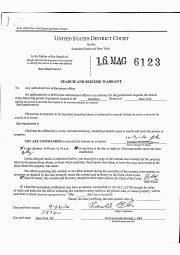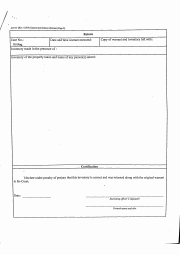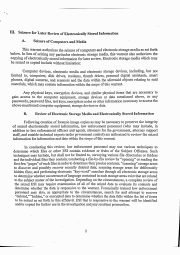Let’s begin with Ploughshares, shall we? Make sure you check the credits at the end of the video. Those that contributed money to the effort are listed here.
Meanwhile, there is a meeting scheduled in Vienna where Germany, France, Britain, Russia and China are to discuss saving the Iran nuclear deal. It is being chaired by Helga Schmid. Will it soon be called the Vienna nuclear deal?
Impact of U.S. Withdrawal from the Iran Nuclear Deal
In Short
The Situation: On Tuesday, May 8, 2018, President Trump announced that the United States has withdrawn from the Iran Nuclear Deal and will fully reimpose its suspended sanctions targeting Iran.
The Result: All currently suspended U.S. sanctions in respect of Iran, including sanctions applicable to non-U.S. persons, will be reimposed by November 5, 2018.
Looking Ahead: The reimposition of U.S. sanctions will have limited impact on U.S. companies. However, foreign companies majority-owned or controlled by U.S. persons must now begin winding down any Iran-related activities. In contrast, the impact of the reimposition of U.S. sanctions on non-U.S. companies is less clear, and as the international response develops, non-U.S. companies will increasingly face a complex compliance landscape.
As reported earlier this week, on May 8, 2018, President Trump announced that the United States will reimpose, after specified wind-down periods, all nuclear-related sanctions lifted under the Joint Comprehensive Plan of Action (“JCPOA”) (commonly known as the “Iran Nuclear Deal”). As a result, the U.S. sanctions regime will revert to its pre-JCPOA scope by November 5, 2018.
In light of the comprehensive U.S. primary sanctions that remained in place after implementation of the JCPOA, President Trump’s announcement will have little impact on U.S. companies. In contrast, foreign subsidiaries of U.S. organizations and their non-U.S. counterparts face a dramatically changed compliance landscape. With the reimposition of U.S. extraterritorial, or secondary, sanctions, non-U.S. companies must navigate increasingly complex terrain as they assess continued engagement with Iran, compliance with U.S. sanctions, and the pending response of the other JCPOA signatories.
Immediate Impact
The background of the JCPOA, the resulting international sanctions relief, and President Trump’s criticism of the deal are, at this point, well-known (see “Iran Nuclear Deal Reached; Sanctions Remain in Place,” “Implementation Day Triggers Significant Changes to International Sanctions Against Iran,” and “Potential Options for U.S. Sanctions on Iran Under the Trump Administration“). Although the policy implications of President’s Trump’s announcement may be subject to debate, the immediate impact is clear. In connection with the announcement, the U.S. Department of the Treasury’s Office of Foreign Assets Control (“OFAC”) issued Frequently Asked Questions setting out a staged reimposition of U.S. sanctions over the next 90 to 180 days (subject to any extension that may be put in place by the United States at a later stage).
Following a 90-day wind-down period ending on August 6, 2018, the United States will reimpose its secondary sanctions targeting activities related to:
- Iran’s automotive sector;
- The sale, supply, or transfer, directly or indirectly, of graphite, raw or semi-finished metals (such as aluminum and steel), coal, and software for integrating industrial processes to or from Iran; and
- Certain financial and banking transactions related to Iranian sovereign debt, the acquisition of U.S. dollar banknotes by the Government of Iran, the purchase or sale of Iranian rials, Iranian rial-denominated funds or accounts, and trade in gold or other precious metals.
During the same period, the United States will revoke the following authorizations:
- The general license authorizing the importation into the United States of Iranian-origin carpets and foodstuffs (as well as certain related financial transactions);
- All specific licenses (and subsequent wind-down authorizations) issued in connection with the Statement of Licensing Policy for Activities Related to the Export or Re-export to Iran of Commercial Passenger Aircraft and Related Parts and Services (“JCPOA SLP”); and
- General License I, which authorized certain transactions related to negotiating and entering contingent contracts for activities covered by the JCPOA SLP.
Following a 180-day wind-down period ending on November 4, 2018, the United States will reimpose its secondary sanctions targeting activities related to:
- Certain transactions by foreign financial institutions with, and provision of specialized financial messaging to, the Central Bank of Iran and/or designated Iranian financial institutions;
- Certain categories of transactions related to Iran’s energy sector, including certain investments (such as participation in joint ventures); provision of goods, services, technology or technical support; the purchase, sale, transport, or marketing of petroleum, petrochemical products, and/or natural gas to or from Iran; and transactions with certain designated persons (such as the National Iranian Oil Company, Naftiran Intertrade Company, and National Iranian Tanker Company);
- Certain transactions involving Iran’s port operators and/or related to Iran’s shipping and shipbuilding sectors, including activities involving the Islamic Republic of Iran Shipping Lines, South Line Iran, or their affiliates; and
- The provision of certain insurance, reinsurance, and underwriting services.
Effective November 5, 2018, the United States will also revoke General License H (and any subsequent wind-down authorizations issued in connection with that general license), which previously authorized foreign entities majority-owned or controlled by U.S. persons to engage in most transactions involving Iran. It appears all other Iran-related general and specific licenses, including licenses issued under the Trade Sanctions Reform and Export Enhancement Act of 2000 (“TSRA”), issued by OFAC will remain unaffected.
Finally, no later than November 5, 2018, the United States will redesignate all persons who had been removed, through the JCPOA, from the List of Specially Designated Nationals and Blocked Persons and/or other U.S. sanctioned parties lists.
Consequently, by November 5, 2018, the United States is currently expected to have reimposed all sanctions that had been lifted pursuant to the JCPOA.
Near- and Long-Term Implications
As a practical matter, the reimposition of U.S. sanctions suspended under the JCPOA will have limited impact on U.S. companies. As noted in our prior Alerts and Commentaries, substantial U.S. sanctions in relation to Iran have remained in place and continued to prohibit U.S. persons from engaging, directly or indirectly, in virtually all transactions or dealings with Iran without authorization.
The reimposition of U.S. sanctions will, however, have immediate impact on non-U.S. organizations that are majority-owned or controlled by U.S. persons and on U.S.-linked aviation companies. As noted above, the United States intends to revoke all specific and general licenses issued in connection with the JCPOA “as soon as administratively feasible,” including General License H and aviation-specific licenses issued under the JCPOA SLP and General License I. In their place, OFAC intends to issue authorizations that will likely narrowly authorize only activities necessary to wind down previously authorized activities. Companies that rely on these authorizations should immediately reassess their existing Iran-related activities, including in-process and pending transactions, in order to prepare to wind down Iran-related activities and ensure compliance with U.S. sanctions during the wind-down period.
The near- and long-term implications of President’s Trump announcement for non-U.S. companies are less clear. Non-U.S. persons are not, with limited exceptions, subject to U.S. primary sanctions. However, U.S. secondary sanctions provide for an array of penalties that, in effect, foreclose access to U.S. markets—a meaningful deterrent for non-U.S. companies. The United States appears poised to rigorously enforce the renewed sanctions and has advised non-U.S. companies to begin winding up soon-to-be sanctionable activities to “avoid exposure to sanctions or an enforcement action when the applicable wind-down period ends.” Continued engagement with Iran will therefore become an increasingly fraught proposition for non-U.S. persons, and one that may be further complicated by the international community’s response to the United States’ withdrawal.
In that regard, following President Trump’s announcement, the European Union has reiterated its commitment to “the continued full and effective implementation of the JCPOA,” as long as Iran meets its nuclear-related obligations, adding that it “is determined to work with the international community” to preserve the deal. Although the European Union has not yet indicated any measures it may implement to preserve the JCPOA, it suggested earlier this year that it may expand its Blocking Regulation—Council Regulation (EC) No. 2271/96 of November 22, 1996—to protect EU-based organizations doing business in Iran following any U.S. withdrawal.
The Blocking Regulation was adopted in 1996 by the European Union (European Communities at the time) in response to the extraterritorial application of U.S. sanctions against Cuba, Iran, and Libya. It prohibits EU companies from complying with blocked sanctions “whether directly or through a subsidiary or other intermediary person, actively or by deliberate omission.” The importance of the Blocking Regulation in the last decade has been limited. This would change if the scope of its application is expanded to cover the U.S. secondary sanctions in relation to Iran, possibly protecting EU companies from enforcement of U.S. judgments or administrative decisions giving effect to the secondary sanctions.
Historically, enforcement of the Blocking Regulation has generally been very limited, but expanding its scope now has the potential to lead to increased enforcement actions across Europe. An expanded Blocking Regulation would, however, place EU companies squarely between the competing demands of U.S. sanctions and EU and national requirements. The European Union may also try to negotiate an exemption for EU companies from the reimposition of the U.S. sanctions. The prospects of relief for EU companies under either approach remains uncertain.
China and Russia have likewise consistently reaffirmed their commitment to the JCPOA, and in a joint statement last month confirmed their “unwavering support” for the deal. In light of current tensions between the United States and Russia and China, it seems unlikely that the U.S. withdrawal will lead Russia or China to alter its commitment to the JCPOA or have a substantial impact on Russian and Chinese business interests in Iran.
As the international response to the U.S. withdrawal from the JCPOA develops, non-U.S. companies should take steps to protect their interests in light of the pending reimposition of U.S. sanctions. In particular, non-U.S. companies should reassess their Iran-related activities to determine their potential liability under the soon-to-be imposed U.S. secondary sanctions and/or any potential blocking statutes; open dialogues with their financial institutions, insurers, and other service providers regarding any Iran-related activities; and, significantly, prepare to possibly wind down any potentially sanctionable Iran-related activities in order to move promptly to comply with U.S. secondary sanctions, if warranted.
Jones Day will continue to monitor developments and provide updates.
Three Key Takeaways
- The U.S. withdrawal from the Iran nuclear agreement will result in the reimposition of sanctions that had been lifted as part of JCPOA, or, the “Iran Nuclear Deal.”
- Because the comprehensive U.S. primary sanctions remained in place after implementation of JCPOA, the withdrawal and reimposition of sanctions hold few consequences for U.S. companies.
- However, foreign subsidiaries of U.S. organizations and their non-U.S. counterparts face a markedly altered compliance situation, and those companies affected should take decisive and deliberate measures to protect their interests.




 Below is the other search warrant.
Below is the other search warrant.


 Bauer on far right
Bauer on far right


